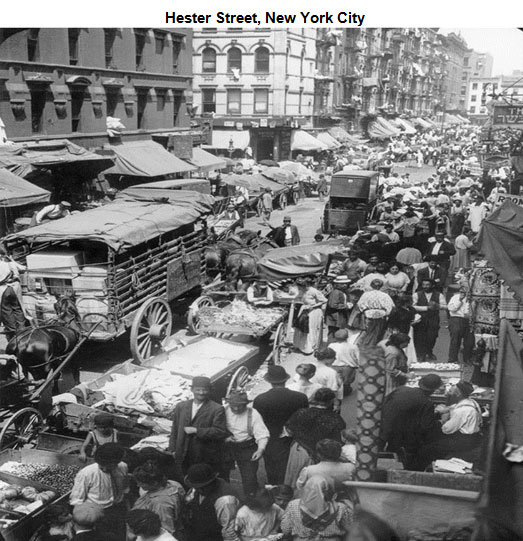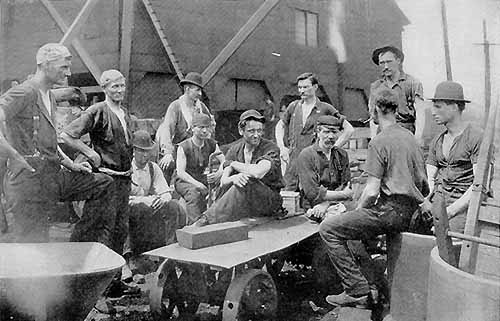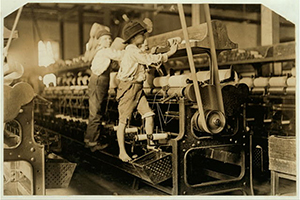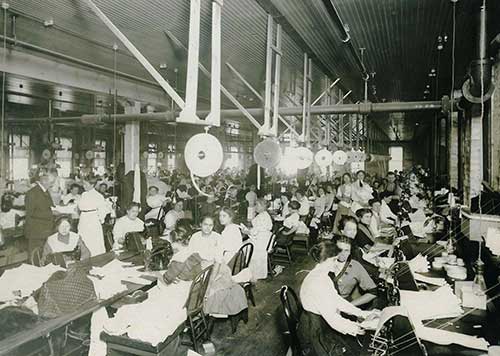The Garment Workers Strike. During the Gilded Age people who worked in factories had only moderate health benefits in case of accidents.
Had only moderate health benefits in case of accidents.

. Log in for more information. 25-35000 deaths and 1 million injuries per year occurred on industrial jobs. During the Gilded Age many children under the age of 15 had to go to work in factories and did many other jobs to help provide for their families so they could buy everyday necessities.
A example of a job in the gilded age that had terrible working conditions was the triangle shirtwaist factory where workers were lock in the sweatshops for 9 hours a day to manufacture a special kind of dress. Factory work was very dangerous and it was difficult if not impossible to hold factory owners responsible for deaths and injuries. Both men and women.
This answer has been confirmed as correct and helpful. From those 117 million immigrants106 million of those immigrants came from Europe which made up 90. The number of women who now had actual jobs had increased drastically.
They worked 10-hour shifts six days a week. As workers moved away from farm work to factories mines and other hard labor they faced harsh working conditions such as long hours low pay and health risks. Safety was a large issue.
Many women preferred to become factory laborers or shop clerks rather than domestic servants. Compared to today workers were extremely vulnerable during the Gilded Age. Had many opportunities for job promotions.
As workers moved away from farm work to factories mines and other hard labor they faced harsh working conditions such as long hours low pay and health risks. During the Gilded Age a growing number of Americans worked in urban areas in manufacturing factories. Millions more worked as domestic servants for people who could afford to pay somebody else to do household chores.
Compared to today workers were extremely vulnerable during the Gilded Age. There were no controlled labor laws during this time in history. This period during the late nineteenth century is often called the Gilded Age implying that under the glittery or gilded surface of prosperity lurked troubling issues including poverty unemployment and corruption.
This era created many new job opportunities than before. Adults worked long and hard and sometimes they were injured as a result of their jobs. Had to work long hours.
The wages they earned were barely enough to support their families. On march 25 1911 the factory caught on fire and many workers were trapped on the 8th floor. The Gilded Age can be characterized as an era of strikes.
During the Gilded Age a growing number of Americans worked in urban areas in manufacturing factories. In cities like New York and Chicago a significant portion of these women worked in the garment industry as dressmakers and embroiderers. Had to work long hours.
Hine photographed many of these children during work. They worked 10-hour shifts six days a week. By the year 1900 38 of the American population lived in cities and these people usually had urbanized jobs at factories.
Children and women worked in factories and generally received lower pay than men. Had many opportunities for job promotions. The working conditions in factories.
The Gilded ages is the period between 1860s to 1896 this was directly after the civil war its part of the reconstruction process and many americans started moving into the urban areas and working in the factories usually working 10 hours shifts 6 days a week for a salary that could barely support a family. In dirty poorly ventilated factories workers had to perform repetitive mind-dulling tasks sometimes with dangerous or faulty equipment. Children and women worked in factories and generally received lower pay than men.
During the Gilded Age people who worked in factories had to work long hours. Men working in a textile factory in 1921. MARK ME AS BRAINLIEST AND GIBE ME POINTS.
Were often taught new skills. During the Gilded Age the shift to a system of mass production that paid workers low wages affected a. During the Gilded Age 1866 until 1900 the factory workers lacked union they were mainly slaves and immigrants.
The wages they earned were barely enough to support their families. During the Gilded Age there were around 117 million people that came to America. Work in factories to survive.
Labor In The Gilded Age. During the Gilded Age people who worked in factories had only moderate health benefits in case of accidents. Between 1880 and 1920 20 percent of women over the age of 10 joined the paid labor force.
Millions of women worked in factories and shops during the Gilded Age. During the Gilded Age factories hired unskilled workers to operate machines. The white people who owned factories would hire immigrants and slaves as well as children to work for them for a very low.
In the Gilded age or the start of the industrial era women and children were forced to leave their homes and try and get jobs in factories that were fit for them. During the Gilded Age there were a large number of immigrants that were coming to North America. Their bosses made them work for very little money or no money at all.
What problems did people face during the Gilded Age. Men women and children b. Adults worked long and hard and sometimes they were injured as a result of their jobs.
Working conditions were very poor during the era of The Gilded Age. Added 3 minutes 18 seconds ago372022 42705 PM. What were working conditions like in the Gilded Age.
In 1882 an average of 675 laborers were killed in work-related accidents each weekIn addition wages were so low that most families could not survive unless everyone held a job. Immigration and other factors lead to a boom in industrial labor and thus also to an increase in dissatisfaction with wages and working conditions. Hine photographed many photos of child labor.
During the Gilded Age people who worked in factories b. Were often taught new skills. During the Gilded Age people who worked in factories had only moderate health benefits in case of accidentshad to work long hourshad many opportunities for job promotionswere often taught new skills.
Immigrants wait in line to enter Ellis Island.
Immigrants In The Workforce Treatment Of Immigrants During The Gilded Age

Notable Labor Strikes Of The Gilded Age

Factory Working Conditions For Both Men And Women During This Time Were Atrocious Picture Show Historical Images Wwi

Saqs For Apush Topic 6 7 Labor In The Gilded Age By Peter Paccone Medium


0 comments
Post a Comment